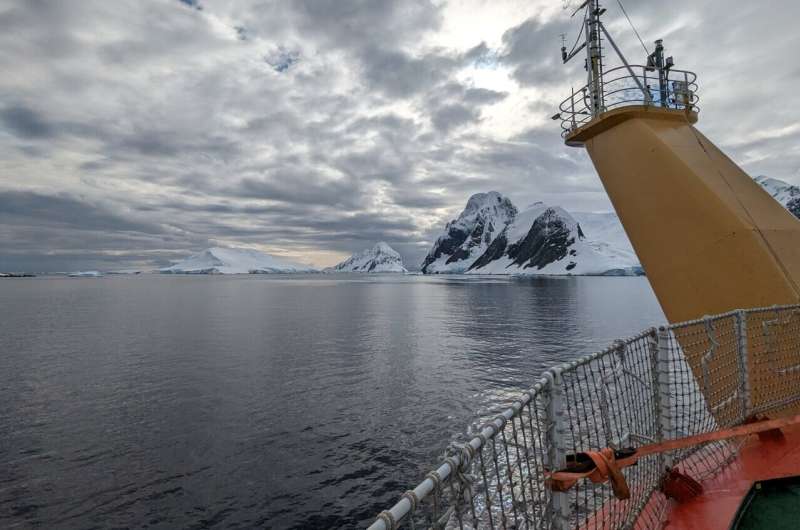This article has been reviewed according to Science X's editorial process and policies. Editors have highlighted the following attributes while ensuring the content's credibility:
fact-checked
peer-reviewed publication
trusted source
proofread
Southern Ocean absorbing more CO₂ than previously thought, study finds

New research led by the University of East Anglia (UEA) and Plymouth Marine Laboratory (PML) has found that the Southern Ocean absorbs more carbon dioxide (CO2) than previously thought.
Using direct measurements of CO2 exchange, or fluxes, between the air and sea, the scientists found the ocean around Antarctica absorbs 25% more CO2 than previous indirect estimates based on shipboard data have suggested.
The Southern Ocean plays a major role in absorbing CO2 emitted by human activities, a process vital for controlling the Earth's climate. However, there are big uncertainties in the magnitude and variability in this flux.
Until now, it has been estimated using shipboard measurements, such as those collected for the Surface Ocean CO2 Atlas (SOCAT) from research ships and sail drones, data from profiling floats deployed in the ocean, and global ocean biogeochemistry models. These different approaches have produced large variations in estimates.
This new study used a novel technique called eddy covariance—with flux systems mounted on ships' foremasts—to directly measure air-sea CO2 fluxes during seven research cruises in the region.
The results, published in the journal Science Advances , show the summer Southern Ocean is likely to be a strong CO2 sink, challenging the much weaker estimates based on float data and model simulations, which the authors say "substantially underestimate" the observed CO2 uptake.
The authors argue this difference can be explained by considering temperature variations in the upper ocean and a limited resolution, for example averaging over a too-long time scale or sampling over a too-large interval, adding that current models and float data do not account for small, intense CO2 uptake events.
Lead author Dr. Yuanxu Dong, of UEA's Center for Ocean and Atmospheric Sciences (COAS) and PML, is currently at the GEOMAR Helmholtz Center for Ocean Research Kiel. He said, "This is the first time a large number of direct air-sea CO2 flux observations have been used to assess existing flux products in the Southern Ocean. Our findings provide direct observational evidence that this ocean may take up more CO2 than previously recognized.
"Accurate quantification of the Southern Ocean CO2 sink is essential for the assessment of the Earth's climate. However, it is the most uncertain region regarding the estimate of its CO2 sink capacity.
"Our study reduces this uncertainty and improves the understanding of Southern Ocean CO2 uptake, and we recommend that future estimates should include temperature adjustments and higher resolution reconstruction and modeling."
The team, which also included scientists at the Alfred Wegener and Max Planck Institutes in Germany, the Flanders Marine Institute in Belgium and University of Hawai'i in the US, investigated inconsistencies in the existing CO2 flux estimates, then used the eddy covariance flux observations to assess the different data sets.
The cruise data covered approximately 3,300 hours—about 175 days—of measurements in the Antarctic summer of 2019 and 2020, defined as November to April in the study, over an area of highly dynamic frontal zones. Measurements were taken hourly compared, for example, to approximately every 10 days for those from floats.
Dr. Mingxi Yang, study co-author and Chemical Oceanographer at PML, said, "The Southern Ocean is a key sink of CO2, but the magnitudes and the locations of this ocean uptake are uncertain. PML's autonomous and high frequency eddy covariance system has significantly increased the number of direct air-sea CO2 flux measurements in this region.
"This paper offers the first comparison between direct CO2 flux measurements and estimates from coarse data products and global models on a large spatial/temporal scale. It has helped validate these and shed light on ways to improve them."
Lack of winter data is a general problem with ships because of the difficulty accessing the region at that time, which the floats partially address. Acknowledging that their cruise data only covers some parts of the Southern Ocean in summer, the authors say continued efforts towards high-quality observations are essential to improve estimates of air-sea CO2 fluxes.
This might include an expansion of measurements to more ships, and the further deployment of buoys and sail drones, particularly in the winter season. Additional observations in winter by unattended platforms could also help fill the seasonal data gap.
Prof Tom Bell, co-author and PML Ocean-Atmosphere Biogeochemist, added, "We have recently moved our flux system onto the new ice breaker, the RRS Sir David Attenborough, and collected the first set of flux measurements during a research cruise in the Weddell Sea earlier this year. We aim to continue this valuable work over the coming years, which is essential for monitoring the current climate and forecasting future changes."
The researchers also warn that the amount of shipboard surface ocean CO2 measurements has drastically declined in recent years, partly due to the COVID pandemic, but also to less funding. The number of annual datasets in SOCAT, for example, decreased by 35% from 2017 to 2021—and 40% for the Southern Ocean.
Dr. Dorothee Bakker, of UEA's COAS and chair of SOCAT, said, "There is a real need for sustained and expanded funding of surface ocean CO2 measurements and their SOCAT synthesis, in order to constrain Southern Ocean CO2 uptake, to support the World Meteorological Organization's Global Greenhouse Gas Watch monitoring initiative and to inform climate policy."
More information: Yuanxu Dong, Direct observational evidence of strong CO2 uptake in the Southern Ocean, Science Advances (2024). DOI: 10.1126/sciadv.adn5781. www.science.org/doi/10.1126/sciadv.adn5781
Journal information: Science Advances
Provided by University of East Anglia




















